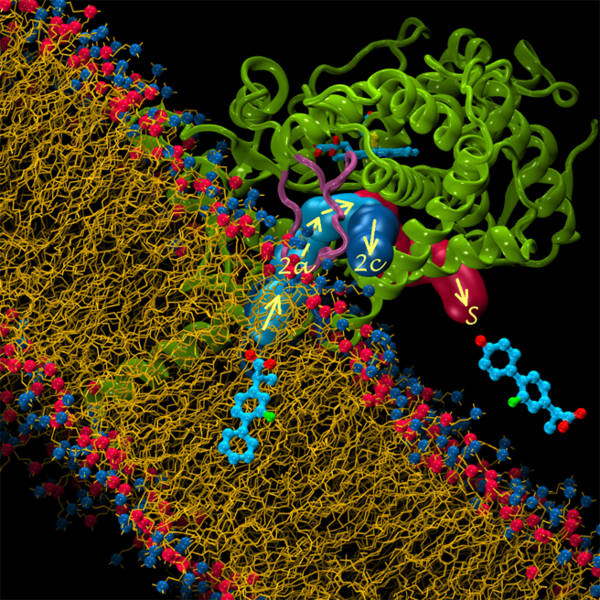HITS 2011: Spider Silk, Phylogenetic Trees and Black Holes

The Heidelberg Institute for Theoretical Studies (HITS) Annual Report 2011 is out: Data-driven science – New insights into the structure of spider silk, the largest evolutionary tree of flowering plants, atomic-detail enzyme models for drug metabolism and simulations of cosmic structure formation
The latest Annual Report 2011 provides insights into the research activities at HITS, the non-profit research institute of the Klaus Tschira foundation. Approximately 70 researchers from 15 countries are conducting basic research in different areas of science, mathematics and computer science.
“Numerous conferences, workshops and some 110 publications show the high level of activity of our researchers,” says Managing Director Prof. Andreas Reuter who jointly manages the Institute together with Dr. h.c. Dr. E.h. Klaus Tschira, the founder of HITS.
Currently, there are six research groups working at HITS. Their common denominator is the processing and structuring of large data volumes and the use of computer simulations.
Why is spider silk incredibly elastic and tear-resistant at the same time? The Molecular Biomechanics group headed by Dr. Frauke Gräter has been using computer simulations to answer this question. The surprising answer is: Fiber such as silk can only be highly elastic and tear-proof at the same time if the components of a fiber are arranged in continuous slices. Researchers from HITS have been cooperating with mechanical engineers at the University of Stuttgart.
The Scientific Computing Group headed by Dr. Alexandros Stamatakis has reconstructed the world’s largest evolutionary tree for angiosperms (flowering plants), together with colleagues at Yale University and Brown University in the U.S. By using this reconstruction, the researchers were able to show that the ancestors of important plant families first experimented with their design and performance and then rapidly created many new species.
Prof. Rebecca Wade and her Molecular and Cellular Modeling (MCM) group, together with colleagues from Italy and France, were able to design peptides which could help fight drug resistance against cancer drugs.
Furthermore, the researchers at HITS simulated key enzymes for drug metabolism, namely the liver-specific, membrane-bound cytochrome P450 enzymes (CYPs). In doing so, they developed the first atomic-detail models of a complete membrane-bound mammal CYP. The visualization of one such model is shown on the cover of the HITS Annual Report.
The Theoretical Astrophysics group (TAP) headed by Prof. Volker Springel and colleagues from Canada and the U.S. found out that diffuse gas in the Universe absorbs the bright gamma radiation emitted by black holes and heats up in the process. This insight has important consequences for the formation of new structures in the Universe.
The Scientific Databases and Visualization group (SDBV) headed by Dr. Wolfgang Müller is responsible for the central data management structure in two large European systems biology consortia: the Virtual Liver Network and SysMO (Systems Biology of Microorganisms). HITS also hosted the second COMBINE workshop in September 2011 which aims at developing new description standards for systems biology.
Computational linguists at the Natural Language Processing group (NLP) headed by Prof. Michael Strube have developed a language-independent method for linking concepts in Wikipedia articles in one language to the same concepts in Wikipedia articles in other languages. This helps users who do not speak one particular language to find information on a certain topic in their own language and promotes the exchange of knowledge regardless of language barriers.
Image:
The HITS Annual Report 2011 cover. A model of the full-length, membranebound human cytochrome P450 2C9, an enzyme essential for drug metabolism in the human liver, derived using an approach that combines coarse-grained and atomic-resolution molecular simulations. This picture was on the frontpage of the Public Library of Science (PLoS) Computational Biology journal, issue 7(8). (Image: Vlad Cojocaru / HITS)
Press contact:
Dr. Peter Saueressig
Head of Communications
Heidelberg Institute for Theoretical Studies (HITS)
Phone: +49-6221-533245
Peter.saueressig@h-its.org
www.h-its.org
Twitter: @HITStudies
About HITS
HITS, the Heidelberg Institute for Theoretical Studies, was established in 2010 by physicist and SAP co-founder Klaus Tschira (1940-2015) and the Klaus Tschira Foundation as a private, non-profit research institute. HITS conducts basic research in the natural, mathematical, and computer sciences. Major research directions include complex simulations across scales, making sense of data, and enabling science via computational research. Application areas range from molecular biology to astrophysics. An essential characteristic of the Institute is interdisciplinarity, implemented in numerous cross-group and cross-disciplinary projects. The base funding of HITS is provided by the Klaus Tschira Foundation.